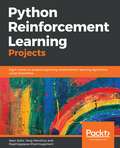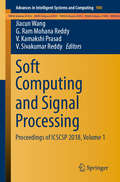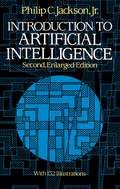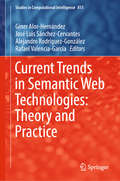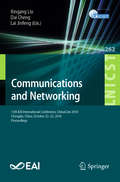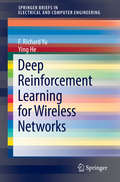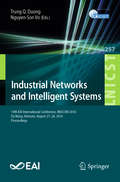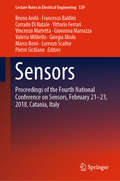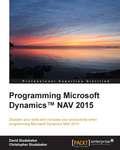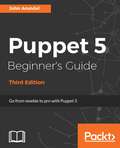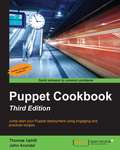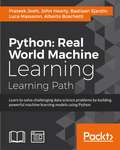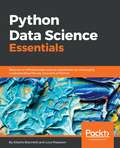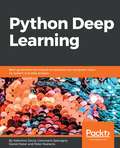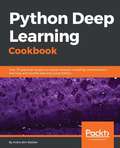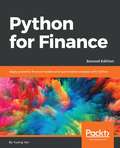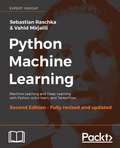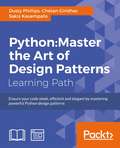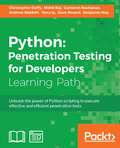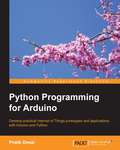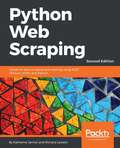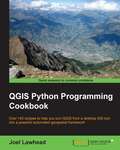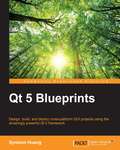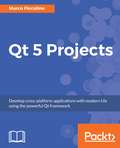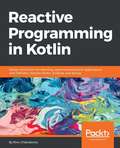- Table View
- List View
Python Reinforcement Learning Projects: Eight hands-on projects exploring reinforcement learning algorithms using TensorFlow
by Sean Saito Yang Wenzhuo Rajalingappaa ShanmugamaniDeploy autonomous agents in business systems using powerful Python libraries and sophisticated reinforcement learning modelsKey FeaturesImplement Q-learning and Markov models with Python and OpenAIExplore the power of TensorFlow to build self-learning modelsEight AI projects to gain confidence in building self-trained applicationsBook DescriptionReinforcement learning (RL) is the next big leap in the artificial intelligence domain, given that it is unsupervised, optimized, and fast. Python Reinforcement Learning Projects takes you through various aspects and methodologies of reinforcement learning, with the help of insightful projects.You will learn about core concepts of reinforcement learning, such as Q-learning, Markov models, the Monte-Carlo process, and deep reinforcement learning. As you make your way through the book, you’ll work on projects with various datasets, including numerical, text, video, and audio, and will gain experience in gaming, image rocessing, audio processing, and recommendation system projects. You’ll explore TensorFlow and OpenAI Gym to implement a deep learning RL agent that can play an Atari game. In addition to this, you will learn how to tune and configure RL algorithms and parameters by building agents for different kinds of games. In the concluding chapters, you’ll get to grips with building self-learning models that will not only uncover layers of data but also reason and make decisions.By the end of this book, you will have created eight real-world projects that explore reinforcement learning and will have handson experience with real data and artificial intelligence (AI) problems.What you will learnTrain and evaluate neural networks built using TensorFlow for RLUse RL algorithms in Python and TensorFlow to solve CartPole balancingCreate deep reinforcement learning algorithms to play Atari gamesDeploy RL algorithms using OpenAI UniverseDevelop an agent to chat with humans Implement basic actor-critic algorithms for continuous controlApply advanced deep RL algorithms to games such as MinecraftAutogenerate an image classifier using RLWho this book is forPython Reinforcement Learning Projects is for data analysts, data scientists, and machine learning professionals, who have working knowledge of machine learning techniques and are looking to build better performing, automated, and optimized deep learning models. Individuals who want to work on self-learning model projects will also find this book useful.
Soft Computing and Signal Processing: Proceedings Of Icscsp 2018, Volume 1 (Advances in Intelligent Systems and Computing #900)
by Jiacun Wang G. Ram Mohana Reddy V. Kamakshi Prasad V. Sivakumar ReddyThe book presents selected research papers on current developments in the field of soft computing and signal processing from the International Conference on Soft Computing and Signal Processing (ICSCSP 2018). It includes papers on current topics such as soft sets, rough sets, fuzzy logic, neural networks, genetic algorithms and machine learning, discussing various aspects of these topics, like technological, product implementation, contemporary research as well as application issues.
Introduction to Artificial Intelligence (Dover Books on Mathematics)
by Philip C. Jackson Jr.Can computers think? Can they use reason to develop their own concepts, solve complex problems, play games, understand our languages? This comprehensive survey of artificial intelligence ― the study of how computers can be made to act intelligently ― explores these and other fascinating questions. Introduction to Artificial Intelligence presents an introduction to the science of reasoning processes in computers, and the research approaches and results of the past two decades. You'll find lucid, easy-to-read coverage of problem-solving methods, representation and models, game playing, automated understanding of natural languages, heuristic search theory, robot systems, heuristic scene analysis and specific artificial-intelligence accomplishments. Related subjects are also included: predicate-calculus theorem proving, machine architecture, psychological simulation, automatic programming, novel software techniques, industrial automation and much more.A supplementary section updates the original book with major research from the decade 1974-1984. Abundant illustrations, diagrams and photographs enhance the text, and challenging practice exercises at the end of each chapter test the student's grasp of each subject.The combination of introductory and advanced material makes Introduction to Artificial Intelligence ideal for both the layman and the student of mathematics and computer science. For anyone interested in the nature of thought, it will inspire visions of what computer technology might produce tomorrow.
Current Trends in Semantic Web Technologies: Theory and Practice (Studies in Computational Intelligence #815)
by Giner Alor-Hernández José Luis Sánchez-Cervantes Alejandro Rodríguez-González Rafael Valencia-GarcíaThis book presents innovative and high-quality research regarding the implementation of Semantic Web technologies for knowledge representation and developing intelligent applications in various domains. Semantic Web technologies have inspired many people to create innovative technologies and applications for knowledge representation, Semantic Searches, NLP and Social Networks. The goal of this book is to collect and consolidate novel and high-quality research contributions on Semantic Web technologies and their theoretical and practical application to a range of different domains. In addition to researchers, the book offers a valuable resource for PhD students, master and undergraduate students in IT-related fields such as Computer Science and Information Systems.
Communications and Networking: 13th Eai International Conference, Chinacom 2018, Chengdu, China, October 23-25, 2018, Proceedings (Lecture Notes of the Institute for Computer Sciences, Social Informatics and Telecommunications Engineering #262)
by Lai Jinfeng Dai Cheng Xingang LiuThe book constitutes the refereed proceedings of the 13th EAI International Conference on Communications and Networking, held in October 2018 in Chengdu, China. The 71 papers presented were carefully selected from 114 submissions. The papers are organized in topical sections on wireless communications and networking, next generation WLAN, big data networks, cloud communications and networking, ad hoc and sensor networks, satellite and space communications and networking, optical communications and networking, information and coding theory, multimedia communications and smart networking, green communications and computing, signal processing for communications, network and information security, machine-to-machine and IoT, communication QoS, reliability and modeling, cognitive radio and networks, smart internet of things modeling, pattern recognition and image signal processing, digital audio and video signal processing, antenna and microwave communications, radar imaging and target recognition, and video coding and image signal processing.
Deep Reinforcement Learning for Wireless Networks (SpringerBriefs in Electrical and Computer Engineering)
by F. Richard Yu Ying HeThis Springerbrief presents a deep reinforcement learning approach to wireless systems to improve system performance. Particularly, deep reinforcement learning approach is used in cache-enabled opportunistic interference alignment wireless networks and mobile social networks. Simulation results with different network parameters are presented to show the effectiveness of the proposed scheme. There is a phenomenal burst of research activities in artificial intelligence, deep reinforcement learning and wireless systems. Deep reinforcement learning has been successfully used to solve many practical problems. For example, Google DeepMind adopts this method on several artificial intelligent projects with big data (e.g., AlphaGo), and gets quite good results.. Graduate students in electrical and computer engineering, as well as computer science will find this brief useful as a study guide. Researchers, engineers, computer scientists, programmers, and policy makers will also find this brief to be a useful tool.
Industrial Networks and Intelligent Systems: 14th Eai International Conference, Iniscom 2018, Da Nang, Vietnam, August 27 - 28, 2018, Proceedings (Lecture Notes of the Institute for Computer Sciences, Social Informatics and Telecommunications Engineering #257)
by Trung Q. Duong Nguyen-Son VoThis book constitutes the refereed proceedings of the 4th EAI International Conference on Industrial Networks and Intelligent Systems, INISCOM 2018, held in Da Nang, Vietnam, in August 2018. The 26 full papers were selected from 38 submissions and are organized thematically in tracks: Telecommunications Systems and Networks; Industrial Networks and Applications; Hardware and Software Design and Development; Information Processing and Data Analysis; Signal Processing; Security and Privacy.
Sensors: Proceedings Of The Second National Conference On Sensors, Rome 19-21 February 2014 (Lecture Notes in Electrical Engineering #319)
by Bruno Andò Francesco Baldini Corrado Di Natale Vittorio Ferrari Vincenzo Marletta Giovanna Marrazza Valeria Militello Giorgia Miolo Marco Rossi Lorenzo Scalise Pietro SicilianoThis book contains a selection of papers presented at the Second National Conference on Sensors held in Rome 19-21 February 2014. The conference highlighted state-of-the-art results from both theoretical and applied research in the field of sensors and related technologies. This book presents material in an interdisciplinary approach, covering many aspects of the disciplines related to sensors, including physics, chemistry, materials science, biology and applications.
Programming Microsoft Dynamics™ NAV 2015
by David Studebaker Christopher StudebakerWritten as a practical guide, this book will show you how to utilize Dynamics NAV 2013 to its full potential. Designed to be a comprehensive reference, it should be the perfect companion for any NAV developer, manager or consultant. This book is for experienced programmers who are either new to Microsoft Dynamics NAV or for experienced developers that want to utilize the fantastic new features of NAV 2013. Managers and consultants will also benefit from understanding NAV environments in order to build on their skills and experience during development projects.
Puppet 5 Beginner's Guide Third Edition
by John ArundelPuppet 5 Beginner's Guide, Third Edition is a practical guide that gets you up and running with the very latest features of Puppet 5.About This Book* Develop skills to run Puppet 5 on single or multiple servers without hiccups* Use Puppet to create and manage cloud resources such as Amazon EC2 instances* Take full advantage of powerful new features of Puppet including loops, data types, Hiera integration, and container managementWho This Book Is ForPuppet 5 Beginner's Guide, Third Edition is designed for those who are new to Puppet, including system administrators and developers who are looking to manage computer server systems for configuration management. No prior programming or system administration experience is assumed.What You Will Learn* Understand the latest Puppet 5 features* Install and set up Puppet and discover the latest and most advanced features* Configure, build, and run containers in production using Puppet's industry-leading Docker support* Deploy configuration files and templates at super-fast speeds and manage user accounts and access control* Automate your IT infrastructure* Use the latest features in Puppet 5 onward and its official modules* Manage clouds, containers, and orchestration* Get to know the best practices to make Puppet more reliable and increase its performanceIn DetailPuppet 5 Beginner's Guide, Third Edition gets you up and running with the very latest features of Puppet 5, including Docker containers, Hiera data, and Amazon AWS cloud orchestration. Go from beginner to confident Puppet user with a series of clear, practical examples to help you manage every aspect of your server setup.Whether you're a developer, a system administrator, or you are simply curious about Puppet, you'll learn Puppet skills that you can put into practice right away. With practical steps giving you the key concepts you need, this book teaches you how to install packages and config files, create users, set up scheduled jobs, provision cloud instances, build containers, and so much more.Every example in this book deals with something real and practical that you're likely to need in your work, and you'll see the complete Puppet code that makes it happen, along with step-by-step instructions for what to type and what output you'll see. All the examples are available in a GitHub repo for you to download and adapt for your own server setup.Style and approachThis tutorial is packed with quick step-by-step instructions that are immediately applicable for beginners. This is an easy-to-read guide, to learn Puppet from scratch, that explains simply and clearly all you need to know to use this essential IT power tool, while applying these solutions to real-world scenarios.
Puppet Cookbook Third Edition
by Thomas Uphill John ArundelPuppet is a configuration management system that automates all your IT configurations, giving you control of what you do to each node, when you do it, and how you do it. Puppet Cookbook Third Edition takes the reader from a basic knowledge of Puppet to a complete and expert understanding of Puppet's latest and most advanced features. Updated with the latest advancements and best practices, it gives you a clear view on how to "connect the dots" and expands your knowledge to successfully use and extend Puppet. This book delves into various aspects of writing good Puppet code, which includes using Puppet community style, checking your manifests with puppet-lint, and learning community best practices, with an emphasis on real-world implementation.
Python: Real World Machine Learning
by Prateek JoshiLearn to solve challenging data science problems by building powerful machine learning models using Python About This Book Understand which algorithms to use in a given context with the help of this exciting recipe-based guide This practical tutorial tackles real-world computing problems through a rigorous and effective approach Build state-of-the-art models and develop personalized recommendations to perform machine learning at scale Who This Book Is For This Learning Path is for Python programmers who are looking to use machine learning algorithms to create real-world applications. It is ideal for Python professionals who want to work with large and complex datasets and Python developers and analysts or data scientists who are looking to add to their existing skills by accessing some of the most powerful recent trends in data science. Experience with Python, Jupyter Notebooks, and command-line execution together with a good level of mathematical knowledge to understand the concepts is expected. Machine learning basic knowledge is also expected. What You Will Learn Use predictive modeling and apply it to real-world problems Understand how to perform market segmentation using unsupervised learning Apply your new-found skills to solve real problems, through clearly-explained code for every technique and test Compete with top data scientists by gaining a practical and theoretical understanding of cutting-edge deep learning algorithms Increase predictive accuracy with deep learning and scalable data-handling techniques Work with modern state-of-the-art large-scale machine learning techniques Learn to use Python code to implement a range of machine learning algorithms and techniques In Detail Machine learning is increasingly spreading in the modern data-driven world. It is used extensively across many fields such as search engines, robotics, self-driving cars, and more. Machine learning is transforming the way we understand and interact with the world around us. In the first module, Python Machine Learning Cookbook, you will learn how to perform various machine learning tasks using a wide variety of machine learning algorithms to solve real-world problems and use Python to implement these algorithms. The second module, Advanced Machine Learning with Python, is designed to take you on a guided tour of the most relevant and powerful machine learning techniques and you'll acquire a broad set of powerful skills in the area of feature selection and feature engineering. The third module in this learning path, Large Scale Machine Learning with Python, dives into scalable machine learning and the three forms of scalability. It covers the most effective machine learning techniques on a map reduce framework in Hadoop and Spark in Python. This Learning Path will teach you Python machine learning for the real world. The machine learning techniques covered in this Learning Path are at the forefront of commercial practice. This Learning Path combines some of the best that Packt has to offer in one complete, curated package. It includes content from the following Packt products: Python Machine Learning Cookbook by Prateek Joshi Advanced Machine Learning with Python by John Hearty Large Scale Machine Learning with Python by Bastiaan Sjardin, Alberto Boschetti, Luca Massaron Style and approach This course is a smooth learning path that will teach you how to get started with Python machine learning for the real world, and develop solutions to real-world problems. Through this comprehensive course, you'll learn to create the most effective machine learning techniques from scratch and more!
Python Data Science Essentials
by Alberto Boschetti Luca MassaronBecome an efficient data science practitioner by understanding Python's key concepts About This Book Quickly get familiar with data science using Python 3.5 Save time (and effort) with all the essential tools explained Create effective data science projects and avoid common pitfalls with the help of examples and hints dictated by experience Who This Book Is For If you are an aspiring data scientist and you have at least a working knowledge of data analysis and Python, this book will get you started in data science. Data analysts with experience of R or MATLAB will also find the book to be a comprehensive reference to enhance their data manipulation and machine learning skills. What You Will Learn Set up your data science toolbox using a Python scientific environment on Windows, Mac, and Linux Get data ready for your data science project Manipulate, fix, and explore data in order to solve data science problems Set up an experimental pipeline to test your data science hypotheses Choose the most effective and scalable learning algorithm for your data science tasks Optimize your machine learning models to get the best performance Explore and cluster graphs, taking advantage of interconnections and links in your data In Detail Fully expanded and upgraded, the second edition of Python Data Science Essentials takes you through all you need to know to suceed in data science using Python. Get modern insight into the core of Python data, including the latest versions of Jupyter notebooks, NumPy, pandas and scikit-learn. Look beyond the fundamentals with beautiful data visualizations with Seaborn and ggplot, web development with Bottle, and even the new frontiers of deep learning with Theano and TensorFlow. Dive into building your essential Python 3.5 data science toolbox, using a single-source approach that will allow to to work with Python 2.7 as well. Get to grips fast with data munging and preprocessing, and all the techniques you need to load, analyse, and process your data. Finally, get a complete overview of principal machine learning algorithms, graph analysis techniques, and all the visualization and deployment instruments that make it easier to present your results to an audience of both data science experts and business users. Style and approach The book is structured as a data science project. You will always benefit from clear code and simplified examples to help you understand the underlying mechanics and real-world datasets.
Python Deep Learning
by Valentino Zocca Gianmario Spacagna Daniel Slater Peter RoelantsTake your machine learning skills to the next level by mastering Deep Learning concepts and algorithms using Python. About This Book Explore and create intelligent systems using cutting-edge deep learning techniques Implement deep learning algorithms and work with revolutionary libraries in Python Get real-world examples and easy-to-follow tutorials on Theano, TensorFlow, H2O and more Who This Book Is For This book is for Data Science practitioners as well as aspirants who have a basic foundational understanding of Machine Learning concepts and some programming experience with Python. A mathematical background with a conceptual understanding of calculus and statistics is also desired. What You Will Learn Get a practical deep dive into deep learning algorithms Explore deep learning further with Theano, Caffe, Keras, and TensorFlow Learn about two of the most powerful techniques at the core of many practical deep learning implementations: Auto-Encoders and Restricted Boltzmann Machines Dive into Deep Belief Nets and Deep Neural Networks Discover more deep learning algorithms with Dropout and Convolutional Neural Networks Get to know device strategies so you can use deep learning algorithms and libraries in the real world In Detail With an increasing interest in AI around the world, deep learning has attracted a great deal of public attention. Every day, deep learning algorithms are used broadly across different industries. The book will give you all the practical information available on the subject, including the best practices, using real-world use cases. You will learn to recognize and extract information to increase predictive accuracy and optimize results. Starting with a quick recap of important machine learning concepts, the book will delve straight into deep learning principles using Sci-kit learn. Moving ahead, you will learn to use the latest open source libraries such as Theano, Keras, Google's TensorFlow, and H20. Use this guide to uncover the difficulties of pattern recognition, scaling data with greater accuracy and discussing deep learning algorithms and techniques. Whether you want to dive deeper into Deep Learning, or want to investigate how to get more out of this powerful technology, you'll find everything inside. Style and approach Python Machine Learning by example follows practical hands on approach. It walks you through the key elements of Python and its powerful machine learning libraries with the help of real world projects.
Python Deep Learning Cookbook
by Indra Den BakkerSolve different problems in modelling deep neural networks using Python, Tensorflow, and Keras with this practical guide About This Book Practical recipes on training different neural network models and tuning them for optimal performance Use Python frameworks like TensorFlow, Caffe, Keras, Theano for Natural Language Processing, Computer Vision, and more A hands-on guide covering the common as well as the not so common problems in deep learning using Python Who This Book Is For This book is intended for machine learning professionals who are looking to use deep learning algorithms to create real-world applications using Python. Thorough understanding of the machine learning concepts and Python libraries such as NumPy, SciPy and scikit-learn is expected. Additionally, basic knowledge in linear algebra and calculus is desired. What You Will Learn Implement different neural network models in Python Select the best Python framework for deep learning such as PyTorch, Tensorflow, MXNet and Keras Apply tips and tricks related to neural networks internals, to boost learning performances Consolidate machine learning principles and apply them in the deep learning field Reuse and adapt Python code snippets to everyday problems Evaluate the cost/benefits and performance implication of each discussed solution In Detail Deep Learning is revolutionizing a wide range of industries. For many applications, deep learning has proven to outperform humans by making faster and more accurate predictions. This book provides a top-down and bottom-up approach to demonstrate deep learning solutions to real-world problems in different areas. These applications include Computer Vision, Natural Language Processing, Time Series, and Robotics. The Python Deep Learning Cookbook presents technical solutions to the issues presented, along with a detailed explanation of the solutions. Furthermore, a discussion on corresponding pros and cons of implementing the proposed solution using one of the popular frameworks like TensorFlow, PyTorch, Keras and CNTK is provided. The book includes recipes that are related to the basic concepts of neural networks. All techniques s, as well as classical networks topologies. The main purpose of this book is to provide Python programmers a detailed list of recipes to apply deep learning to common and not-so-common scenarios. Style and approach Unique blend of independent recipes arranged in the most logical manner
Python for Finance Second Edition
by Yuxing YanA hands-on guide with easy-to-follow examples to help you learn about option theory, quantitative finance, financial modeling, and time series using Python. Python for Finance is perfect for graduate students, practitioners, and application developers who wish to learn how to utilize Python to handle their financial needs. Basic knowledge of Python will be helpful but knowledge of programming is necessary.
Python Machine Learning Second Edition
by Sebastian Raschka Vahid MirjaliliUnlock modern machine learning and deep learning techniques with Python by using the latest cutting-edge open source Python libraries. About This Book Second edition of the bestselling book on Machine Learning A practical approach to key frameworks in data science, machine learning, and deep learning Use the most powerful Python libraries to implement machine learning and deep learning Get to know the best practices to improve and optimize your machine learning systems and algorithms Who This Book Is For If you know some Python and you want to use machine learning and deep learning, pick up this book. Whether you want to start from scratch or extend your machine learning knowledge, this is an essential and unmissable resource. Written for developers and data scientists who want to create practical machine learning and deep learning code, this book is ideal for developers and data scientists who want to teach computers how to learn from data. What You Will Learn Understand the key frameworks in data science, machine learning, and deep learning Harness the power of the latest Python open source libraries in machine learning Explore machine learning techniques using challenging real-world data Master deep neural network implementation using the TensorFlow library Learn the mechanics of classification algorithms to implement the best tool for the job Predict continuous target outcomes using regression analysis Uncover hidden patterns and structures in data with clustering Delve deeper into textual and social media data using sentiment analysis In Detail Machine learning is eating the software world, and now deep learning is extending machine learning. Understand and work at the cutting edge of machine learning, neural networks, and deep learning with this second edition of Sebastian Raschka's bestselling book, Python Machine Learning. Thoroughly updated using the latest Python open source libraries, this book offers the practical knowledge and techniques you need to create and contribute to machine learning, deep learning, and modern data analysis. Fully extended and modernized, Python Machine Learning Second Edition now includes the popular TensorFlow deep learning library. The scikit-learn code has also been fully updated to include recent improvements and additions to this versatile machine learning library. Sebastian Raschka and Vahid Mirjalili's unique insight and expertise introduce you to machine learning and deep learning algorithms from scratch, and show you how to apply them to practical industry challenges using realistic and interesting examples. By the end of the book, you'll be ready to meet the new data analysis opportunities in today's world. If you've read the first edition of this book, you'll be delighted to find a new balance of classical ideas and modern insights into machine learning. Every chapter has been critically updated, and there are new chapters on key technologies. You'll be able to learn and work with TensorFlow more deeply than ever before, and get essential coverage of the Keras neural network library, along with the most recent updates to scikit-learn. Style and Approach Python Machine Learning Second Edition takes a practical, hands-on coding approach so you can learn about machine learning by coding with Python. This book moves fluently between the theoretical principles of machine learning and the practical details of implementation with Python.
Python: Master the Art of Design Patterns
by Dusty Phillips Chetan Giridhar Sakis KasampalisEnsure your code is sleek, efficient and elegant by mastering powerful Python design patterns About This Book Learn all about abstract design patterns and how to implement them in Python 3 Understand the structural, creational, and behavioral Python design patterns Get to know the context and application of design patterns to solve real-world problems in software architecture, design, and application development Discover how to simplify Design Pattern implementation using the power of Python 3 Who This Book Is For If you have basic Python skills and wish to learn in depth how to correctly apply appropriate design patterns, this course is tailor made for you. What You Will Learn Discover what design patterns are and how to apply them to writing Python Implement objects in Python by creating classes and defining methods Separate related objects into a taxonomy of classes and describe the properties and behaviors of those objects via the class interface Understand when to use object-oriented features, and more importantly when not to use them Get to know proven solutions to common design issues Explore the design principles that form the basis of software design, such as loose coupling, the Hollywood principle, and the Open Close principle, among others Use Structural Design Patterns and find out how objects and classes interact to build larger applications Improve the productivity and code base of your application using Python design patterns Secure an interface using the Proxy pattern In Detail Python is an object-oriented scripting language that is used in everything from data science to web development. Known for its simplicity, Python increases productivity and minimizes development time. Through applying essential software engineering design patterns to Python, Python code becomes even more efficient and reusable from project to project. This learning path takes you through every traditional and advanced design pattern best applied to Python code, building your skills in writing exceptional Python. Divided into three distinct modules, you'll go from foundational to advanced concepts by following a series of practical tutorials. Start with the bedrock of Python programming – the object-oriented paradigm. Rethink the way you work with Python as you work through the Python data structures and object-oriented techniques essential to modern Python programming. Build your confidence as you learn Python syntax, and how to use OOP principles with Python tools such as Django and Kivy. In the second module, run through the most common and most useful design patterns from a Python perspective. Progress through Singleton patterns, Factory patterns, Facade patterns and more all with detailed hands-on guidance. Enhance your professional abilities in in software architecture, design, and development. In the final module, run through the more complex and less common design patterns, discovering how to apply them to Python coding with the help of real-world examples. Get to grips with the best practices of writing Python, as well as creating systems architecture and troubleshooting issues. This Learning Path combines some of the best that Packt has to offer in one complete, curated package. It includes content from the following Packt products: Python 3 Object-Oriented Programming - Second Edition by Dusty Phillips Learning Python Design Patterns - Second Edition by Chetan Giridhar Mastering Python Design Patterns by Sakis Kasampalis Style and approach Advance your Python code through three distinct modules that each build on preceding content. Get the complete coverage of Python design patterns you need to write elegant and efficient code that's reusable and powerful.
Python: Penetration Testing for Developers
by Christopher Duffy Mohit Cameron Buchanan Terry Ip Andrew Mabbitt Benjamin May Dave MoundUnleash the power of Python scripting to execute effective and efficient penetration tests About This Book Sharpen your pentesting skills with Python Develop your fluency with Python to write sharper scripts for rigorous security testing Get stuck into some of the most powerful tools in the security world Who This Book Is For If you are a Python programmer or a security researcher who has basic knowledge of Python programming and wants to learn about penetration testing with the help of Python, this course is ideal for you. Even if you are new to the field of ethical hacking, this course can help you find the vulnerabilities in your system so that you are ready to tackle any kind of attack or intrusion. What You Will Learn Familiarize yourself with the generation of Metasploit resource files and use the Metasploit Remote Procedure Call to automate exploit generation and execution Exploit the Remote File Inclusion to gain administrative access to systems with Python and other scripting languages Crack an organization's Internet perimeter and chain exploits to gain deeper access to an organization's resources Explore wireless traffic with the help of various programs and perform wireless attacks with Python programs Gather passive information from a website using automated scripts and perform XSS, SQL injection, and parameter tampering attacks Develop complicated header-based attacks through Python In Detail Cybercriminals are always one step ahead, when it comes to tools and techniques. This means you need to use the same tools and adopt the same mindset to properly secure your software. This course shows you how to do just that, demonstrating how effective Python can be for powerful pentesting that keeps your software safe. Comprising of three key modules, follow each one to push your Python and security skills to the next level. In the first module, we'll show you how to get to grips with the fundamentals. This means you'll quickly find out how to tackle some of the common challenges facing pentesters using custom Python tools designed specifically for your needs. You'll also learn what tools to use and when, giving you complete confidence when deploying your pentester tools to combat any potential threat. In the next module you'll begin hacking into the application layer. Covering everything from parameter tampering, DDoS, XXS and SQL injection, it will build on the knowledge and skills you learned in the first module to make you an even more fluent security expert. Finally in the third module, you'll find more than 60 Python pentesting recipes. We think this will soon become your trusted resource for any pentesting situation. This Learning Path combines some of the best that Packt has to offer in one complete, curated package. It includes content from the following Packt products: Learning Penetration Testing with Python by Christopher Duffy Python Penetration Testing Essentials by Mohit Python Web Penetration Testing Cookbook by Cameron Buchanan,Terry Ip, Andrew Mabbitt, Benjamin May and Dave Mound Style and approach This course provides a quick access to powerful, modern tools, and customizable scripts to kick-start the creation of your own Python web penetration testing toolbox.
Python Programming for Arduino
by Pratik DesaiThis is the book for you if you are a student, hobbyist, developer, or designer with little or no programming and hardware prototyping experience, and you want to develop IoT applications. If you are a software developer or a hardware designer and want to create connected devices applications, then this book will help you get started.
Python Web Scraping, Second Edition
by Katharine Jarmul Richard LawsonSuccessfully scrape data from any website with the power of Python 3.xAbout This Book* A hands-on guide to web scraping using Python with solutions to real-world problems* Create a number of different web scrapers in Python to extract information* This book includes practical examples on using the popular and well-maintained libraries in Python for your web scraping needsWho This Book Is ForThis book is aimed at developers who want to use web scraping for legitimate purposes. Prior programming experience with Python would be useful but not essential. Anyone with general knowledge of programming languages should be able to pick up the book and understand the principals involved.What You Will Learn* Extract data from web pages with simple Python programming* Build a concurrent crawler to process web pages in parallel* Follow links to crawl a website* Extract features from the HTML* Cache downloaded HTML for reuse* Compare concurrent models to determine the fastest crawler* Find out how to parse JavaScript-dependent websites* Interact with forms and sessionsIn DetailThe Internet contains the most useful set of data ever assembled, most of which is publicly accessible for free. However, this data is not easily usable. It is embedded within the structure and style of websites and needs to be carefully extracted. Web scraping is becoming increasingly useful as a means to gather and make sense of the wealth of information available online.This book is the ultimate guide to using the latest features of Python 3.x to scrape data from websites. In the early chapters, you'll see how to extract data from static web pages. You'll learn to use caching with databases and files to save time and manage the load on servers. After covering the basics, you'll get hands-on practice building a more sophisticated crawler using browsers, crawlers, and concurrent scrapers.You'll determine when and how to scrape data from a JavaScript-dependent website using PyQt and Selenium. You'll get a better understanding of how to submit forms on complex websites protected by CAPTCHA. You'll find out how to automate these actions with Python packages such as mechanize. You'll also learn how to create class-based scrapers with Scrapy libraries and implement your learning on real websites.By the end of the book, you will have explored testing websites with scrapers, remote scraping, best practices, working with images, and many other relevant topics.Style and approachThis hands-on guide is full of real-life examples and solutions starting simple and then progressively becoming more complex. Each chapter in this book introduces a problem and then provides one or more possible solutions.
QGIS Python Programming Cookbook
by Joel LawheadMaster over 170 recipes that will help you turn QGIS from a desktop GIS tool into a powerful automated geospatial framework About This Book Delve into the undocumented features of the QGIS API Get a set of user-friendly recipes that can automate entire geospatial workflows by connecting Python GIS building blocks into comprehensive processes This book has a complete code upgrade to QGIS 2.18 and 30 new, valuable recipes Who This Book Is For This book is for geospatial analysts who want to learn more about automating everyday GIS tasks as well as programmers responsible for building GIS applications. The short, reusable recipes make concepts easy to understand and combine so you can build larger applications that are easy to maintain. What You Will Learn Use Python and QGIS to produce captivating GIS visualizations and build complex map layouts Find out how to effectively use the poorly-documented and undocumented features of the QGIS Python API Automate entire geospatial workflows by connecting Python GIS building blocks into comprehensive processes Create, import, and edit geospatial data on disk or in-memory Change QGIS settings programmatically to control default behavior Automatically generate PDF map books Build dynamic forms for field input In Detail QGIS is a desktop geographic information system that facilitates data viewing, editing, and analysis. Paired with the most efficient scripting language—Python, we can write effective scripts that extend the core functionality of QGIS. Based on version QGIS 2.18, this book will teach you how to write Python code that works with spatial data to automate geoprocessing tasks in QGIS. It will cover topics such as querying and editing vector data and using raster data. You will also learn to create, edit, and optimize a vector layer for faster queries, reproject a vector layer, reduce the number of vertices in a vector layer without losing critical data, and convert a raster to a vector. Following this, you will work through recipes that will help you compose static maps, create heavily customized maps, and add specialized labels and annotations. As well as this, we'll also share a few tips and tricks based on different aspects of QGIS. Style and approach This book follows a recipe-based problem-solution approach to address and dispel challenges faced when implementing and using QGIS on a regular basis.
Qt 5 Blueprints
by Symeon HuangIf you are a programmer looking for a truly cross-platform GUI framework to help you save your time by side-stepping the incompatibility between different platforms and building applications using Qt 5 for multiple targets, then this book is most certainly intended for you. It is assumed that you have a basic programming experience of C++ and fundamental knowledge about Qt.
Qt 5 Projects: Develop Cross-platform Applications With Modern Uis Using The Powerful Qt Framework
by Marco PiccolinoDesign, build, and deploy powerful applications with amazing user interfaces on embedded, mobile, and desktop platforms Key Features Easily compile, run, and debug your applications from the powerful Qt Creator IDE Future-proof your applications with Qt Test and modern architecture principles Build multi-platform projects that target Android, iOS, Windows, macOS, Linux, and more Book Description Qt is a professional cross-platform application framework used across industries like automotive, medical, infotainment, wearables, and more. In this book you’ll initially create a to-do style app by going via all stages for building a successful project. You'll learn basics of Qt's C++ and QML APIs, test-driven development with Qt Test, application architecture, and UIs with Qt Quick & Quick Controls 2. Next, you’ll help two startups build their products. The first startup, Cute Comics, wants to help independent comic creators with a suite of apps that let them experiment with comic pages, image composition, comic dialogues, and scene descriptions. While developing these apps you’ll deepen your knowledge of Qt Quick's layout systems, and see Qt 3D and Widgets in action. The second startup, Cute Measures, wants to create apps for industrial and agricultural sectors, to make sense of sensor data via a monitoring system. The apps should run seamlessly across devices and operating systems like Android, iOS, Windows, or Mac, and be cost-effective by integrating with existing web technologies. You take the role of lead developer and prototype the monitoring system. In doing so you’ll get to know Qt's Bluetooth and HTTP APIs, as well as the Charts and Web Engine UI modules. These projects will help you gain a holistic view of the Qt framework. What you will learn Learn the basics of modern Qt application development Develop solid and maintainable applications with BDD, TDD, and Qt Test Master the latest UI technologies and know when to use them: Qt Quick, Controls 2, Qt 3D and Charts Build a desktop UI with Widgets and the Designer Translate your user interfaces with QTranslator and Linguist Get familiar with multimedia components to handle visual input and output Explore data manipulation and transfer: the model/view framework, JSON, Bluetooth, and network I/O Take advantage of existing web technologies and UI components with WebEngine Who this book is for This book is for developers who want to successfully build and maintain cross-platform applications with advanced UI and connectivity features. Basic knowledge of C++ is required.
Reactive Programming in Kotlin
by Rivu ChakrabortyLearn how to implement Reactive Programming paradigms with Kotlin, and apply them to web programming with Spring Framework 5.0 and in Android Application Development. About This Book Learn how to solve blocking user experience with Reactive Programming and get deep insights into RxKotlin Integrate Reactive Kotlin with Spring and build fantastic Android Apps with RxKotlin and RxAndroid Build reactive architectures that reduce complexity throughout the development process and make your apps(web and Android) scalable Who This Book Is For This book is for Kotlin developers who would like to build fault-tolerant, scalable, and distributed systems. A basic knowledge of Kotlin is required, but no prior knowledge of reactive programming. What You Will Learn Learn about reactive programming paradigms and how reactive programming can improve your existing projects Gain in-depth knowledge in RxKotlin 2.0 and the ReactiveX Framework Use RxKotlin with Android Create your own custom operators in RxKotlin Use Spring Framework 5.0 with Kotlin Use the reactor-kotlin extension Build Rest APIs with Spring,Hibernate, and RxKotlin Use testSubscriber to test RxKotlin applications Use backpressure management and Flowables In Detail In today's app-driven era, when programs are asynchronous, and responsiveness is so vital, reactive programming can help you write code that's more reliable, easier to scale, and better-performing. Reactive programming is revolutionary. With this practical book, Kotlin developers will first learn how to view problems in the reactive way, and then build programs that leverage the best features of this exciting new programming paradigm. You will begin with the general concepts of Reactive programming and then gradually move on to working with asynchronous data streams. You will dive into advanced techniques such as manipulating time in data-flow, customizing operators and provider and how to Use the concurrency model to control asynchronicity of code and process event handlers effectively. You will then be introduced to functional reactive programming and will learn to apply FRP in practical use cases in Kotlin. This book will also take you one step forward by introducing you to spring 5 and spring boot 2 using Kotlin. By the end of the book, you will be able to build real-world applications with reactive user interfaces as well as you'll learn to implement reactive programming paradigms in Android. Style and Approach Loaded with numerous code examples and real-life projects, this book helps you delve into Reactive Programming with Kotlin, and apply it to real-world Spring-web and Android projects, thus making all your apps reactive.
